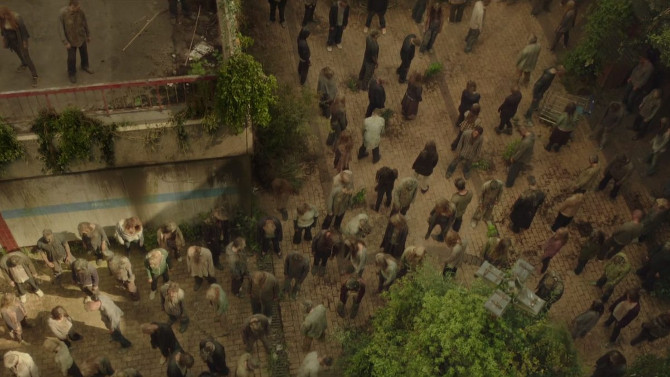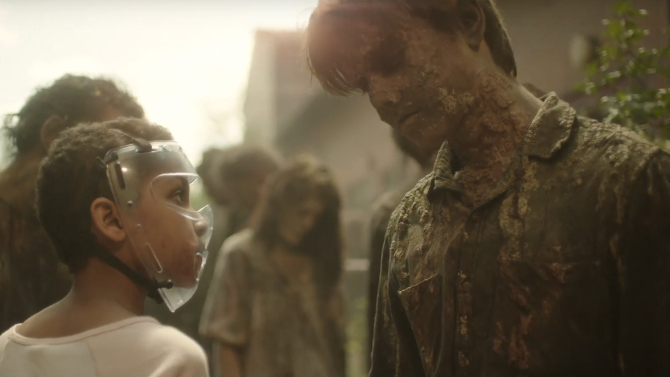Children: those cute, innocent little scamps that bring a smile to our faces get a frightening makeover in Colm McCarthy’s The Girl with All the Gifts – a 2016 zombie horror flick out of Britain that finds some interesting new ground within the sub-genre.
Finding a place somewhere between Day of the Dead and 28 Days Later, a small group of people have kept some normalcy at a military base (much of which is underground – similar to the former film mentioned above). . . mostly armed soldiers, the men fall under the control of Sgt. Eddie Parks (Paddy Considine), who only answers to Dr. Caroline Caldwell (Glenn Close) – a military scientist who has been tasked with researching the fungal outbreak that has caused a worldwide zombie-like plague (only the creatures are excessively fast, much like the latter feature referenced above).
Having discovered a group of children born during the outbreak, they look human but also contain the fungal virus (like a case of Dr. Jekyll and Mr. Hyde, this means that if they smell humans, they transform into the violent, super-hungry creatures) – giving a whole new meaning to the term ankle biters. . . the personnel utilize a special oil that covers their scent, making them quasi-odourless.
Dr. Caldwell has tasked Helen Justineau (Gemma Arterton) with educating the youngins. Her star pupil is Melanie (Sennia Nanua), a prodigy who not only shows amazing intellect, but also compassion and the ability to hold off her violent outbursts for a short time. Despite the ointment, and the children’s relative humanity, they are treated with hatred and distaste by the entire compound, the exception to the rule being Justineau. . . the kids only tolerated due to the fact that Dr. Caldwell believes the cure is somewhere within them.
As these things go, the base is overrun by the massive hordes that have slowly gathered outside the fences, forcing Dr. Caldwell, Sgt. Parks, Ms. Justineau, Melanie and another soldier, Kieran Gallagher (Fisayo Akinade), out on the road, a small party surrounded by ever more wild elements and constantly encroaching ‘hungries’. It is a dangerous path, their only refuge forcing them to go through ominous London to reach another military encampment. Will the rag tag team, low on food and water, be able to make the trek through the wildlife zombie park city? Is Melanie the cure? And, perhaps more importantly, is Melanie truly alive, or is the virus simply mimicking human life?
As much a philosophical tale as it is a horror driven one, screenwriter Mike Carey (adapting the film from his own novel), brings us in on the existential question of what it is to be human. Melanie, a compassionate girl whose intellect is growing on a daily basis (at a rather impressive rate), is in many ways better than many of those seen onscreen. She is arguably no more a monster than Dr. Caldwell, or Sgt. Parks, who have both done horrible things to survive, losing their humanity in a way that Melanie has not had to (as she does not have to fear for her life – immune to the walkers as she carries the same strain).
Further muddling things, there is the question of whether it is right, just, or perhaps simply a tolerable evil to dissect this child in order to find a cure for the disease. Does anything go at this point? If you do take that path, is there any coming back from it? Likely, each audience member will have a different perspective, and the film making team nicely mirror these opinions with our main characters. Dr. Caldwell’s drive for a cure is unwavering – a one track focus ingrained in her brain from the outset of the program. Ms. Justineau, their teacher, is the only one to truly care for the children, her affection and maternal style of teaching in stark opposition to her superior’s views. The soldiers, as expected, start off as cold, sullen individuals, yet, intriguingly, it is young Melanie who is the genesis for change, her spirit and love infectious, so that even these battle-hardened men begin to soften as they get farther into their journey (it tying in nicely to the philosophical quandaries discussed earlier). In a sense, they are becoming more human, this rejuvenation coming from something that is not wholly human itself – an absolutely fascinating perspective. Perhaps some of the answers to these, and your questions, following a watch, will go back to Greek mythology, as it plays a vital role in Ms. Justineau’s teachings while on the base. . . a Pandora’s Box filled with troubles, but lest we forget that there is still hope remaining.
Developing a realistic landscape for its characters to inhabit (drone shots from around Chernobyl, while abandoned bus stops and malls in Britain were used to provide a realistic perspectives of formerly lived-in locations that are now abandoned), The Girl with All the Gifts balances its tale nicely – paying homage to the zombie masters of old while carving out some entertaining, and oft thought provoking, new ground. Featuring stellar performances (keep an eye out for young Nanua), a mesmerizing pace, and a chilling story, some may have some issues with the third act, a divisive conclusion that does not shy away from the motion picture’s thought provoking nature (the ending, without giving too much away, further develops the idea of free will, human nature and the survival instincts of the infection). So, for some sporeadic scares and fungal times, sprout a copy of The Girl with All the Gifts, it is an educational experience.



